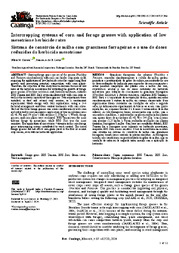Intercropping systems of corn and forage grasses with application of low mesotrione herbicide rates.
Intercropping systems of corn and forage grasses with application of low mesotrione herbicide rates.
Autoria: CORREIA, N. M.; LENZA, R. A. do B.
Resumo: ABSTRACT - Sowing forage grass species of the genera Urochloa and Panicum simultaneously with corn can hinder crop grain yield, requiring the application of low herbicide rates for suppressing their growth and preventing potential competition with corn plants. Therefore, the objective of this study was to evaluate the use of low rates of the herbicide mesotrione for inhibiting the growth of forage grass species (Urochloa ruziziensis and Panicum maximum, cultivars BRS Tamani and BRS Zuri) sown simultaneously with corn crop, as well as the recovery capacity of these grasses. Two experiments were installed, as first and second crop seasons, in a randomized experimental block design with four replications, using a 3×4 factorial arrangement and three control treatments with corn alone. Each of the three forage grasses was sown simultaneously with corn and subjected to post-emergence application of four mesotrione rates (0, 48, 96, and 144 g ha-1) with atrazine (1.25 kg ha-1). Weeds, forage grasses, and corn plants were evaluated. BRS Tamani was the most tolerant forage to mesotrione, while BRS Zuri was the most sensitive. The application of mesotrione + atrazine in the corn-forage grass intercropping system contributed to weed control. The tested forage grasses did not affect corn grain yield in the first or second crop season, even with no herbicide application.
Ano de publicação: 2024
Tipo de publicação: Artigo de periódico
Unidade: Embrapa Cerrados
Palavras-chave: BRS Tamani, BRS Zuri, Brachiaria Ruziziensis, Erva Daninha, Forage grasses, Herbicides, Manejo, Mesotrione, Urochloa
Observações
1 - Por padrão são exibidas publicações dos últimos 20 anos. Para encontrar publicações mais antigas, configure o filtro ano de publicação, colocando o ano a partir do qual você deseja encontrar publicações. O filtro está na coluna da esquerda na busca acima.
2 - Para ler algumas publicações da Embrapa (apenas as que estão em formato ePub), é necessário ter, no celular ou computador, um desses softwares gratuitos. Sistemas Android: Google Play Livros; IOS: iBooks; Windows e Linux: software Calibre.
Acesse outras publicações
Acesse a Base de Dados da Pesquisa Agropecuária (BDPA) para consultar o acervo completo das bibliotecas da Embrapa.

